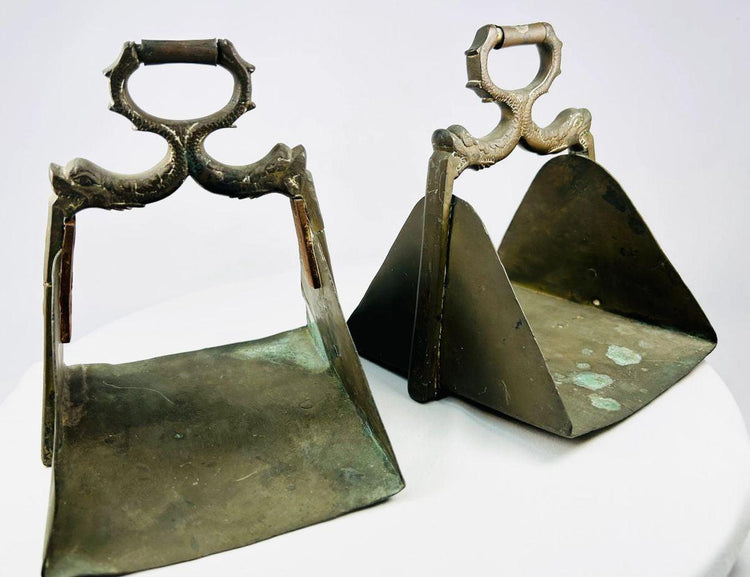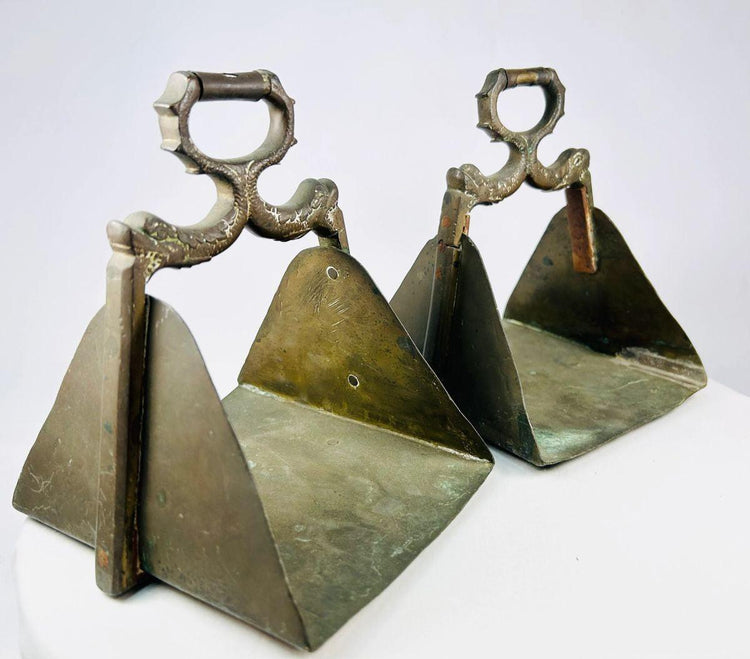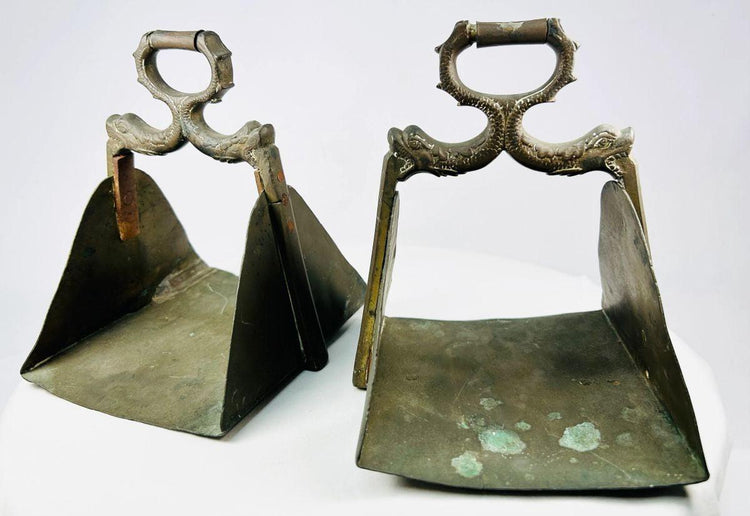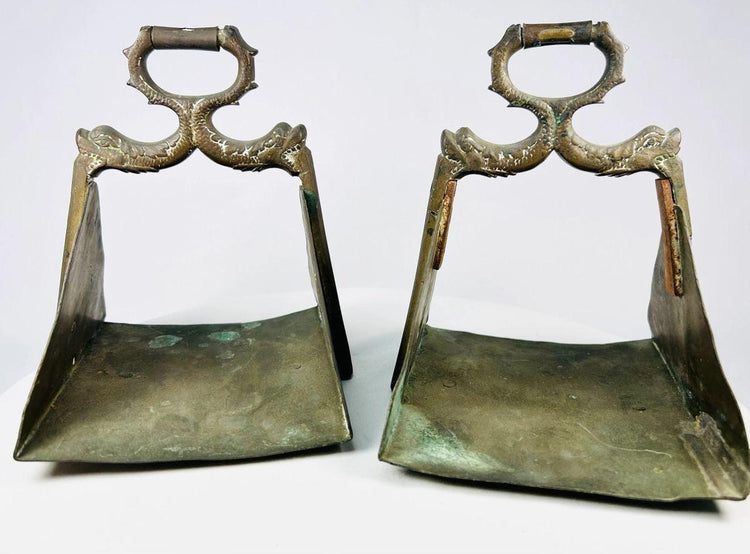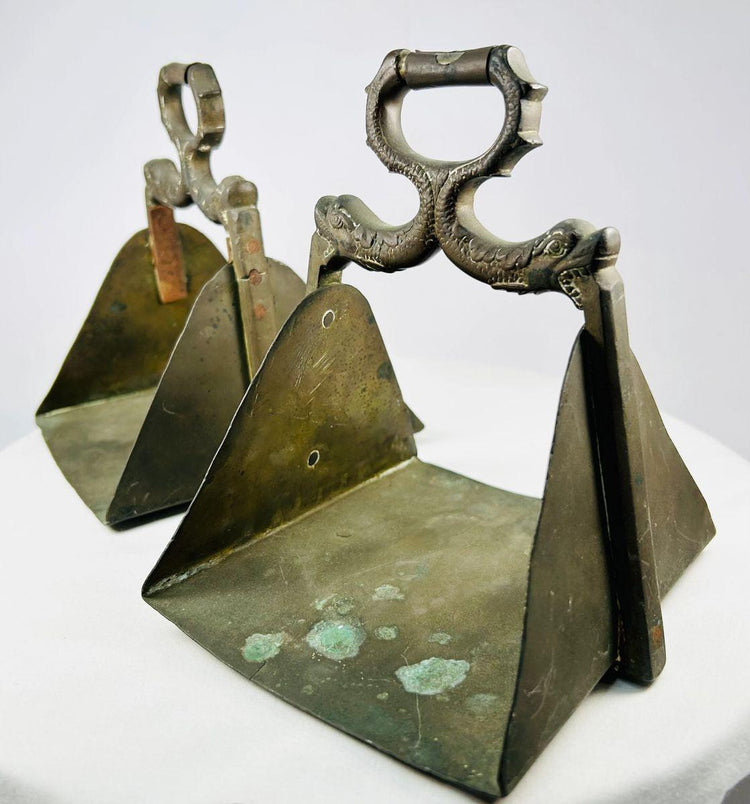Pair of Ornate Brass Equestrian Stirrups | Serpentine Motif | Late 17th–Early 18th
Description
More
Less
Historical Context & Origin
Region: Europe (likely Spain or Italy)
Material: Cast brass
Period: Late 17th to Early 18th Century (possibly extending into 19th century)
Description
This remarkable pair of hand-crafted brass stirrups exemplifies the artistry and functionality of Renaissance and early modern equestrian equipment. Featuring wide, slightly curved footbeds, protective flared side panels, and ornate serpentine or mythical creature motifs on the handles, these stirrups demonstrate both utilitarian design and decorative sophistication. The golden tone of the brass has aged into a warm patina, enriched with traces of verdigris that emphasize their centuries-old history. Their form reflects not only practical riding needs but also ceremonial or status-related use, where equestrian accessories symbolized nobility, strength, and prestige.
Features
-
Elaborate serpent or mythical creature motif on handles
-
Wide curved footbeds for stability and comfort
-
Flared side panels for rider protection
-
Hand-finished edges with fine ornamental detailing
-
Rich aged patina with verdigris highlights
Cultural Significance
Equestrian gear of this type was more than functional—it served as a visible marker of rank, wealth, and martial authority. In Spain and Italy, where horsemanship was deeply tied to military life, these ornate stirrups would have been used by noble riders or during ceremonial events. Their symbolic design reflects the dual role of horses as both practical mounts and powerful cultural symbols of status, mobility, and mastery.
Condition
The stirrups are in very good antique condition. They exhibit a deep, naturally aged patina with patches of verdigris along seams and crevices. Minor surface wear, light indentations, and oxidation are consistent with prolonged use and age. No structural damage or modern restorations are present, and the integrity of the pair remains strong.
Dimensions (approximate)
Height: 7 in
Age
Estimated 300–350 years old
Learn More
Dive Into the History & Development of the Stirrup
Description
Historical Context & Origin
Region: Europe (likely Spain or Italy)
Material: Cast brass
Period: Late 17th to Early 18th Century (possibly extending into 19th century)
Description
This remarkable pair of hand-crafted brass stirrups exemplifies the artistry and functionality of Renaissance and early modern equestrian equipment. Featuring wide, slightly curved footbeds, protective flared side panels, and ornate serpentine or mythical creature motifs on the handles, these stirrups demonstrate both utilitarian design and decorative sophistication. The golden tone of the brass has aged into a warm patina, enriched with traces of verdigris that emphasize their centuries-old history. Their form reflects not only practical riding needs but also ceremonial or status-related use, where equestrian accessories symbolized nobility, strength, and prestige.
Features
-
Elaborate serpent or mythical creature motif on handles
-
Wide curved footbeds for stability and comfort
-
Flared side panels for rider protection
-
Hand-finished edges with fine ornamental detailing
-
Rich aged patina with verdigris highlights
Cultural Significance
Equestrian gear of this type was more than functional—it served as a visible marker of rank, wealth, and martial authority. In Spain and Italy, where horsemanship was deeply tied to military life, these ornate stirrups would have been used by noble riders or during ceremonial events. Their symbolic design reflects the dual role of horses as both practical mounts and powerful cultural symbols of status, mobility, and mastery.
Condition
The stirrups are in very good antique condition. They exhibit a deep, naturally aged patina with patches of verdigris along seams and crevices. Minor surface wear, light indentations, and oxidation are consistent with prolonged use and age. No structural damage or modern restorations are present, and the integrity of the pair remains strong.
Dimensions (approximate)
Height: 7 in
Age
Estimated 300–350 years old
Learn More
Dive Into the History & Development of the Stirrup
You May Also Like



















